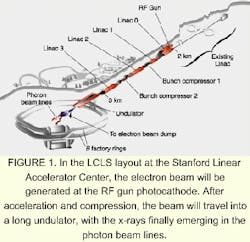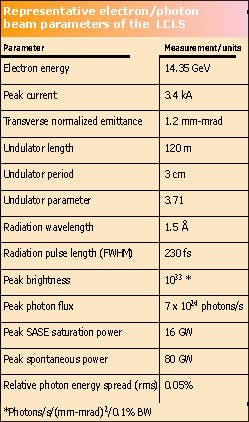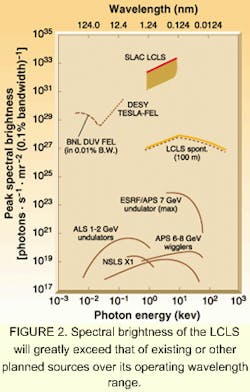X-ray FELs may shed light on the molecular world
Theo Kotseroglou, Patrick Krejcik, and Paul Emma
A gigawatt-level coherent ultrafast hard x-ray emitter would breathe new life into research in live-cell imaging, phonon excitation, warm dense matter, and even genomics.A new generation of x-ray free-electron lasers (FELs) utilizing high-quality electron beams has the potential to rejuvenate research areas that have been limited by an inability to use solid-state or other conventional laser technology. These sources go beyond current synchrotron light sources and are poised to generate ultrafast hard x-rays with high spatial and temporal coherence at power levels more than adequate to explore new fields in science.
The Linac Coherent Light Source (LCLS), which is based on the effect of self-amplified spontaneous emission (SASE), is such an x-ray device. It is also the only such design currently under evaluation in the United States (see Fig. 1). While the LCLS machine is still a few years away from fruition (mostly due to funding constraints), experiments applicable to the device are already in the planning stage.
A variety of biological, atomic, and plasma physics applications could someday benefit from these systems. For example, a coherent 100-fs pulsed laser operating at a 1.5-Å wavelength and gigawatt power could expand research into live-cell imaging in "the water window," phonon excitation, warm dense matter, and even genomics.
Exploring the human genome
In recent months, the Human Genome Project has made headlines around the world.1, 2 Related research areas such as genomics, proteomics, and bioinformatics have the potential to radically change our lives. Moreover, biological functions depend on interacting components, more like "molecular systems." Imaging these systems in three dimensions and observing their changes in time is what the x-ray FEL will provide.
Although light microscopy has made great advances in imaging cells with confocal techniques, the resolution for three-dimensional (3-D) images remains on the order of 100 nm. Electron imaging has generated 10-nm resolution tomographic images, but only for thin (less than 1 µm) frozen specimens. X-ray-based devices offer an opportunity to image whole eukaryotic cells of 10-µm thickness at 30-nm resolution.3
One proposed experiment to study these eukaryotic cells uses zone plates that magnify two holograms from different nearfield distances in the specimen onto a charge-coupled-device camera. By rotating the sample through many angles, it is possible to build a 3-D image.
As of yet, though, no 3-D structure of any genome is available. Instead, scientists only have access to a faint picture of the packing of the genetic material in intact viruses due to the fact the nucleic acid inside the virus does not crystallize like the outer shell does, so the resulting image is rotationally averaged over many angles. Holographic reconstruction of the virus using x-ray techniques could be pivotal in enhancing such images.
Also of interest for FEL-based experiments are structural studies of nanoclusters, nanocrystals, and single-protein molecules. Such projects could use the high photon flux and possibly the spatial coherence of the x-ray pulse, but they may require slightly shorter bunch lengths (10 to 100 fs) than the existing LCLS baseline design (200 fs). This has prompted investigation of new schemes of electron-beam and x-ray pulse compression, leading to some promising designs.
A related area of potential study involves femtochemistry experiments using ultrafast lasers as the pumping devices and x-ray pulses as the probing elements. Chemical reactions and physical transformations entail the breaking and rearranging of intra- or intermolecular bonds on a femtosecond timescale, with distances approaching a few angstroms in length. Hard x-ray lasers could aid in the study of atomic motions in real time related to photochemically induced bond breakage in solutions and the subsequent recombination of such elements. It also may be possible to observe internal and surface motions of nanoparticles, or quantum dots, using similar pump/probe techniques.
The LCLS has the potential for use in these and a vast range of other atomic physics and condensed matter experiments. Other topical areas include the study of the dynamics of entangled polymers, glassy dynamics, and collective mode dynamics in liquids and glasses.
X-ray FEL design
The fourth-generation LCLSa collaboration among several US research laboratorieswill be based at the Stanford Linear Accelerator Center (SLAC; Menlo Park, CA). Plans are for construction to begin sometime in 2004 pending funds.4
Compared to existing sources, the device's 1.5-Å x-rays reportedly will possess superior coherence, brightness, and temporal characteristics (see table). Current third-generation devices generate synchrotron radiation in high-energy electron storage rings that are optimized for multiple insertion devices, including wigglers and undulators, to provide short-wavelength radiation. The LCLS concept forgoes the high average brightness of a recirculating beam in favor of a single-pass system in which the electron bunches from a high-energy linear accelerator (linac) are directed through a long (120-m) magnetic undulator. The objective of this single-pass concept is to tailor the electron-bunch properties to the undulator design and create the world's first FEL producing hard x-rays.
The gain length of the FEL undulator is around 4 m, depending on the exact electron-bunch parameters. At 1.5-Å, mirrors cannot be used to recirculate the photon beam and seed the FEL, so this is a single-pass FEL in which the coherent radiation grows exponentially over approximately 20 gain lengths before reaching saturation. This explains the 120 m required for the undulator.
Because the spontaneous radiation is emitted incoherently, its power increases only linearly with the number of electrons. To increase the peak brightness, the LCLS FEL will increase the number of photons per electron by many orders of magnitude using the microbunching process on the scale of the radiation wavelength. For this collective instability to occur, the density of electrons in phase space must be high. The saturation characteristic is critical to the FEL operation, since it makes the output radiation power insensitive to minor fluctuations in the electron-bunch charge and other parameters.
With LCLS, the peak power at saturation will be 9 GW. The peak brightness will be 1033 photons/(s-mm2-mrad2-0.1% bandwidth), as determined by the charge density and peak current in the electron bunches (see Fig. 2).
Plans for an eventual upgrade to the existing linac at SLAC will allow LCLS operation in conjunction with the high-energy physics program. A new radio-frequency (RF) photoinjector gun (2.856 GHz) will inject very low transverse-emittance (1 mm-mrad) electron bunches into the last kilometer of the SLAC linac. The laser-illuminated cathode of the RF gun will produce bunches of 2.8-ps root-mean-square (rms) in duration and 1-nC charge. The linac will accelerate these bunches to 14.35 GeV and apply a factor-of-35 temporal compression to produce peak currents of 3.5 kA in the undulator.
This design accomplishes compression by inducing a linear energy chirp along the electron bunch using an off-crest RF accelerating phase. The ultra-relativistic electrons are then passed through a series of magnetic chicanes (systems of bend magnets) with path length dependent on electron energy.
Usage of two compression stages will desensitize the system to pulse-to-pulse bunch timing and charge errors, and eliminate nonlinear limitations inherent in a single stage of compression. The first stage at 250 MeV will compress to 0.7-ps rms, while the final stage will initially produce a 200-fs-rms pulse at 4.5 GeV or higher. At each stage, the bunch will only be partially compressed so that a linear energy chirp remains, even after the final compression to 200 fs. To reduce this chirp before the undulator, the design will rely on the strong longitudinal wakefield (self-induced field) of the accelerating structures. This is an efficient way to reduce the final relative-energy spread and provide a narrow band of x-ray radiation of less than 0.05% rms in width.
The need to preserve the beam brightness essentially dominates the design of the linac optics and compressor chicanes. Effects such as transverse wakefields in misaligned accelerating structures and coherent synchrotron radiation in the chicanes can dilute the transverse emittance.
Specifically, coherent radiation is produced in the bend magnets for wavelengths longer than the bunch length. As the electrons pass the bends, the forward radiation from the tail of the bunch could catch up with the head due to the electron-photon path-length difference. The radiation field would then generate an evolving energy gradient within the bunch, which could couple into the bend-plane emittance. This effect, although most pronounced for short bunches, could be mitigated through the use of weak bends and the introduction of a double-chicane for each compression stage. Separating the chicane pairs by optical symmetry would reduce the coupling from the longitudinal to transverse planes.
The technology and instrumentation of the LCLS are quite challenging. Consider that solid-state lasers with 1- to 10-ps shaped pulse widths, energies of a few millijoules, a 240-nm wavelength, and 120-Hz repetition rates create photoelectrons on the cathode of an RF electron gun. The intensity stability required to maintain the FEL power is thus 1% rms in the ultraviolet. Synchronization of the laser oscillator phase to the phase of the RF that powers the accelerating modules must be held to a level below 1-ps rms. Similar constraints exist on the laser system used in pump-probe experiments. The only difference is that LCLS has the source and the experimental laser located more than 1 km apart.
Also challenging are the x-ray optics that will be required to shape, deflect, attenuate, compress, and finally deliver the x-rays to the biological or other samples for study. Since transmissive focusing optics at these wavelengths are not very effective for focal lengths that are close to the diameter of the LCLS pulse, the system will require grazing-incidence reflective optics. Because of such high peak powers, the optical systems require the use of advanced materials with high damage thresholds.
Future view
The LCLS has the potential to bring fourth-generation light sources toward fruition on a large scale. Reliance on chirp induced in a laser beam has already benefited science greatly, with the creation and subsequent use of ultrafast laser pulses in infrared and ultraviolet wavelengths during the past decade. Temporal compression of electron beams by similar methods, as well as the subsequent production of x-rays, could have a similar impact in the next decade.
It is also interesting to note one conclusion of the US Department of Energy's Basic Energy Sciences Advisory Committee Panel on novel coherent light sources: "There is a symbiotic relationship between future accelerator-based sources and high-power ultrafast lasers. Future light sources will involve a complete marriage of accelerator principles and lasers."5
REFERENCES
- International Human Genome Sequencing Consortium, Nature 409 (February 15, 2001).
- J. C. Venter et al., Science 291 (February 16, 2001).
- "LCLS, the first experiments," SLAC report (September 2000).
- LCLS design study report, SLAC-R-521.
- Report of the Basic Energy Sciences Advisory Committee Panel of the Department of Energy on Novel Coherent Light Sources (January 1999).
THEO KOTSEROGLOU is a senior engineer with Illumina Inc., 9390 Town Centre Dr., San Diego, CA 92121; e-mail: [email protected]. PATRICK KREJCIK and PAUL EMMA are scientists with the Stanford Linear Accelerator Center, 2575 Sand Hill Rd., Menlo Park, CA 94025.



